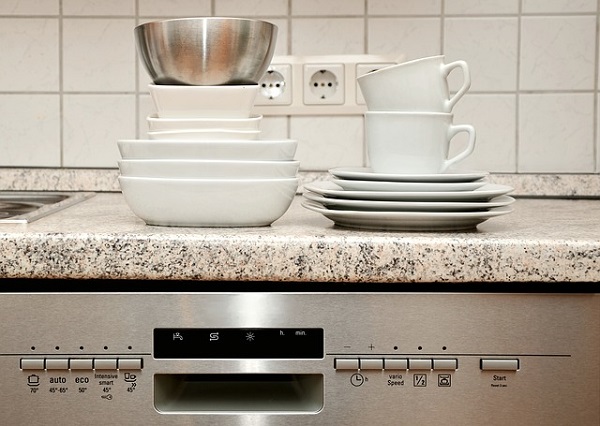
0800 377 7507
Get in touchCleaning White Goods: Revitalising the workhorses! (Part one)
Are your washing machine and dishwasher needing some special care and attention after a hard work out this summer? To ensure their longevity and their efficiency, follow the below top tips from the domestic cleaning professionals, MOLLY MAID, for revitalising and cleaning your white goods – the workhorses – of the household.
Washing Machine
- Detergent drawer: For a front-loading washing machine, remove the detergent drawer gently (if you are in any doubt, please consult your instruction booklet). We all know that this drawer can sometimes accumulate excess washing powder or liquid and in order to ensure that your clothes continue to be washed effectively, it is important to clean the drawer. Firstly, remove the clogged up soap, soak the drawer in warm water, then give it a good brush with a washing up brush. Then, to remove any bacteria wipe the drawer with white vinegar – this will also remove unpleasant smells.
- Rubber gasket: Before you start cleaning the drum, clean the rubber bands that run around the drum thoroughly. This is where fluff, mould and items that are left in pockets can collect. The easiest way to clean the gaskets is wipe around them with a damp microfibre cloth to remove the debris and then as above, wipe with white vinegar.
- Clean the drum: In order to clean the drum of your machine, put on a hot water cycle wash and add a cup of white vinegar, which will disinfect the machine and remove any unpleasant odours. Once the cycle is finished, leave the drum to dry by keeping the washing machine’s door open.
- Filter: You will find that most washing machines have a filter of some sort and it is generally located at the front. It is really important to give it due attention and to clean it out to remove anything from hair, tissues and even toys which have been left in pockets! In order to clean the filter, have a bowl, kitchen towels and cloths to the ready (to collect any water that may come out) then simply open the hatch and remove the contents.
- Routine – After every wash: In order to help your washing machine to run smoothly between uses, if is a good idea that as a matter of routine, you leave the door of the machine open, to prevent bacteria from breeding. Try to give the rubber gasket a quick wipe too!
Dishwasher
After a busy summer of constant barbeques, parties and pic-nics, some routine cleaning of this workhorse is needed to extend the life and efficiency of the appliance.
- Door & Edges: As doors and edges are not cleaned during the dishwasher cycle it is important to clean these areas to prevent bacteria from developing. Using a damp cloth clean around the door and edges paying particular attention to under the bottom of the door where water droplets may have formed. We all know how bacteria love warm and damp areas!
- Drain: The drain is located at the bottom of the dishwasher underneath the arm. This can often be clogged up and when this happens, water will not drain efficiently. So, remove any debris that has accumulated on the outside and wipe with a damp cloth. If you suspect that the inside of the drain is blocked, please consult your instruction booklet. More often than not, they will suggest that you unplug the dishwasher and remove the screws that seal the cover. When the cover has been removed, solid debris can be loosed with a toothbrush before wiping with a cloth.
- Cleaning Of Spinning Arms: Run the cycle before checking spinning arms for debris, which may be clogging the water holes. A useful tool for this job is a wooden toothpick is ideal as it’s important not to use sharp metal as it may damage the arms. If the holes are too small for a toothpick, then remove as much of the debris as possible, then run a thin metal wire through starting at the hole furthest from the arm centre. Make a hook on the end so you don’t lose it.
- Clean Rinse Aid Compartment: Much like the detergent drawer of a washing machine, it is important not to forget the rinse aid compartment of a dishwasher. With a damp cloth, wipe around the drawer and remove any debris that may have collected over time.
- Hard Water Deposits: We all know how damaging hard water can be to appliances and especially when dealing with water jets. Hard water can also lead to a build-up of deposits on the heating element, which in turn, will increase the amount of electricity used, whilst reducing the cleaning efficiency and life of the appliance. Cloudy glasses may indicate that hard water should be a concern. To test, immerse a glass in vinegar, if after five minutes the cloudiness has been removed t the appearance was due to the hard water. If the cloudiness remains then it’s probably due to etchings which can be addressed by a change to a liquid detergent. To remove hard water deposits empty the dishwasher, then place a cup of distilled white vinegar or lemon juice on the upper shelf and run a short cycle. To prevent further build-up of hard water, ensure that you regularly top up your dishwasher with dishwasher salt as recommended in the instructions. This should help to keep hard water deposits at bay!
